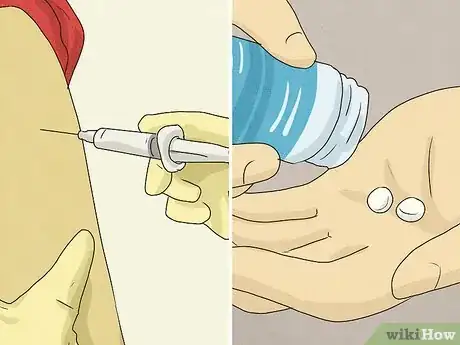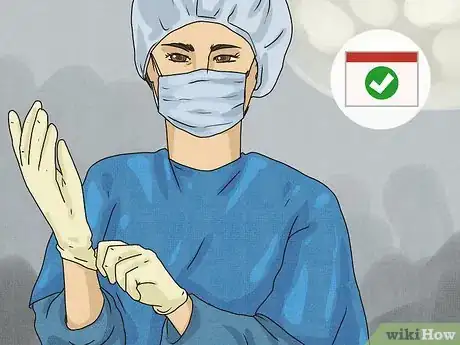This article was co-authored by Deb Schneider, LCSW, PPSC and by wikiHow staff writer, Madeleine Criglow. Deb Schneider is a Licensed Clinical Social Worker in private practice in Oakland, CA, and a Program Manager for the Weiland Health Initiative at Stanford University. With over 15 years of experience, she specializes in creating safe spaces, respectful of marginalized identities, at the high school and college levels. Deb holds a Bachelor’s degree in Sociology and Women's Studies from Clark University and a Master of Social Work (MSW) with Health Concentration from the University of California, Berkeley School of Social Welfare.
There are 11 references cited in this article, which can be found at the bottom of the page.
This article has been viewed 9,358 times.
If you're thinking about transitioning, you probably have some questions about how to make that decision and about the process itself. Whether you're considering transitioning as a man, woman, or gender-fluid individual, we're here to help. We'll start by touching on some common signs that may indicate transitioning is right for you. Then, we'll discuss the steps you can take during your social or medical transition. This may feel like an overwhelming or confusing time, but know that it's also an amazing opportunity to live as your authentic gender identity.
Steps
Signs that you may want to transition
-
1You don’t identify with the gender you were assigned at birth. You might have been labeled as a boy or a girl when you were born, but feel like you should have been assigned the opposite gender. It's also possible that you don't identify with being a boy or a girl at all or feel like your gender changes fluidly. This might mean you identify as non-binary, gender-queer, xenogender, or gender-fluid.[1] If you're feeling any of these emotions, it may mean you would like to transition. [2]
- You might be uncomfortable dressing in the clothes that are typically associated with the gender you were assigned at birth.
- You may feel drawn to spend time with people who are the gender you identify with rather than the one you were assigned at birth.
- You may feel like you don't identify with the gender binary and would prefer to identify as neither a man nor a woman (non-binary, gender-queer, or xenogender).
- You might feel like the gender you were assigned at birth sometimes, but also identify with other genders as well (gender-fluid).
-
2You're drawn to experimenting with another gender identity. You might want to wear clothes, participate in activities, and be thought of by other people as a different gender than the one you were assigned at birth. These feelings indicate that you might be ready to start transitioning.[3]
- It's possible that you were assigned male at birth, but want to wear more feminine clothing and be seen as a woman in public.
- You may be interested in hiding or accentuating different body parts depending on your true gender identity. For example, you might be curious about using a binder to hide your breasts.
- You might want to reject the concept of binary gender and be referred to by they/them pronouns or neopronouns like ze/hir or xe/xem.
Advertisement -
3You experience symptoms of gender dysphoria. This diagnosis refers to feeling uncomfortable with the differences between your true gender identity and the body you were born with. You might feel unhappy or uncomfortable about certain body parts that don't align with your gender identity. You may also feel distressed about being referred to and treated like the gender you were assigned at birth. If you're experiencing this, you might find relief by transitioning.[4]
- Gender dysphoria can also manifest in the form of anxiety, depression, self-harming behaviors, eating disorders, substance abuse, and suicidal ideation. If you're experiencing symptoms like this, consider seeing a gender therapist. They can give you the tools and resources you need to work through these tough feelings. To find a therapist, search online or get a referral from your doctor.
- If you don't have access to a therapist right now, try resources online like https://translifeline.org/ or https://www.thetrevorproject.org/. These organizations offer free 24-hour hotlines, anonymous peer support, and information on finding a counselor.
- Not every trans person experiences gender dysphoria. It's also completely normal to know that you don't identify with the gender you were assigned at birth, but feel comfortable and happy with your body the way it is right now.
Transitioning socially
-
1Come out to your friends and family. After some personal exploration, you might find that you're ready to start living as your authentic gender identity. To start that process, you might consider coming out to your friends and family.[5] To do that, pick a time when your friends or family are free to talk in private and let them know. You might consider writing a letter or printing out some resources to help you explain how you're feeling and encourage them to understand.[6]
- You might say, "I want to let you know something important about my identity. Although I was assigned male at birth, I'm actually a woman. I'm still me, but I want to start living as my authentic gender identity. I'd be happy to talk more about this if you have any questions."
- If you don't feel safe coming out to your family and friends right now, it's totally okay to wait. Coming out is a very personal decision, and when you decide to do it is entirely up to you. Wait to come out until you feel safe, secure, and supported.
- Consider connecting with a trans community, either in-person or online, if you're not able to come out right now. Try organizations like https://translifeline.org/, https://www.thetrevorproject.org/, or https://thesafezoneproject.com/.
- You can also connect with the trans community online using message boards like https://www.transgenderpulse.com/forums/ and https://tgforum.com/.
-
2Request that people use your desired pronouns. Part of living as your authentic gender identity is being referred to as the correct pronouns. Pronouns you might consider include she/her, he/him, they/them, or even a combination of the three if you are gender fluid, genderqueer, or non-binary. As you get more comfortable, you might consider asking your classmates, teachers, or colleagues to refer to you as your correct pronouns.[7]
- It's okay if you're still experimenting with what pronouns work for you. Part of the social transitioning process is exploring your gender identity in public, so it's totally fine if you still have questions or are not 100% sure about your identity just yet.
- If you find that you're often being misgendered at work or school, see if you have any allies that can help correct those people so that you don't always have to. A supportive friend or colleague would be happy to help. You might say, "I've been having a tough time getting people to use my pronouns. Next time you hear someone refer to me as a woman, do you think you could correct them?"
-
3Change your name if you would like. Though you don't have to change your name, picking a new name can help you feel more aligned with your true gender identity. Take all the time you need to find the name that feels right to you, then let your friends, family, and colleagues know. You might also consider legally changing your name when you're ready.[8]
- If you work, you might consider telling HR about your name change so that they can change your name on things like name tags, your workplace email, and workplace documents.
- You might be in school when you change your name. When you're ready, tell all of your professors or teachers and the administrative office so that they can change your name on things like your school email, assignments, and other documents.
- The process to legally change your name varies depending on what state you live in. Most require you to fill out a name change form and submit a decree to change your name. You might also be required to pay a fee.[9]
-
4Present in ways that correspond to your true gender expression. After coming out, you might feel ready to appear in public as your true gender identity. That might look like wearing more feminine clothes, like dresses and skirts, after coming out as a woman, or wearing more masculine clothes if you have come out as a man. You also may want to change your grooming habits by growing out your hair or refraining from shaving your legs. Many people also consider things like binding, tucking, or packing to live as their authentic gender identity.[10]
- Binding refers to using a tight chest wrap to hide your breasts underneath your clothes.
- Tucking is the process of hiding your testicles in the inguinal canal and keeping them in place with form-fitting underwear or a gaff (underwear designed for tucking).
- Packing involves using any type of prosthetic, packing pouch, or clothing item to give yourself a bulge in your pants.
Transitioning medically
-
1Undergo hormone therapy (HRT). After transitioning socially, you might feel ready to transition medically. If you're a trans woman, talk to a trans-friendly doctor about taking estrogen and anti-androgens. If you're a trans man, ask about taking testosterone. Genderqueer, non-binary, or gender-fluid individuals can ask about taking the hormones that feel right for them. Depending on your healthcare provider and where you live, you may need a letter of recommendation or a mental health assessment from a therapist to be approved.[11] [12]
- If you're not sure that you want to transition medically, know that that's totally normal and okay. You don't have to change anything about your body for your gender identity to be valid, and many trans people opt out of transitioning medically for their own personal reasons.
- A trans-friendly therapist will likely be happy to provide a letter of recommendation or a mental health assessment; however, If you're also experiencing severe mental health problems, like psychosis or mania, they may decide to treat those first.
- If you're under 18, you'll also need parental consent. Though it's difficult to be approved for HRT without this, you do have options. If it's serious that you start your medical transition now and your parents won't approve, you might consider emancipation to legally make your own medical decisions.
- Conditions like hormone-sensitive cancer (i.e. prostate cancer) or deep vein thrombosis might make going on HRT more risky for your health. A doctor can work with you to come up with the hormone therapy plan that's right for you.[13]
-
2Remember that you don’t have to medically transition. You might feel pressured to transition medically so that your identity is taken seriously. As tough as this may be, remind yourself that your identity is valid no matter what you decide. Your health history or financial situation might make medically transitioning difficult or impossible at the moment, or you might not feel the need to undergo medical procedures to affirm your gender identity. There's no right or wrong way to transition, so do what feels right for you.
- Talk to a doctor about your options if you have underlying health conditions that might affect your ability to transition.
- Understand the risks of medically transitioning without a medical professional. Transitioning without a doctor (i.e. using hormones you received through non-medical sources) might cause serious problems like blood clots, high blood pressure, and liver damage.[14]
- If you identify as trans but are happy with the way your body is right now, that is 100% normal and valid.
-
3Weigh whether surgery is right for you. After you've come out and transitioned socially, you might feel ready to schedule surgical procedures that can help your body align with your true gender identity. Each of these procedures has specific medical requirements and costs, and some might be covered by your insurance. To start the process, talk to your doctor or search for a trans-friendly doctor in your area online. Then, schedule a consultation to learn more about the procedures.[15]
- If you're a trans woman, you might consider procedures like a breast augmentation, orchiectomy (removal of the testicles), a vaginoplasty (vaginal reconstructive surgery), or facial feminization surgery.
- A trans man might think about undergoing a hysterectomy (removal of the uterus, cervix, and sometimes the fallopian tubes), de-feminizing breast reconstructive surgery (removal of the breasts), or facial masculinization surgery.
- Genderqueer, non-binary, or gender-fluid individuals might consider a combination of these surgeries to help their body match their true gender expression.
References
- ↑ https://positivesexuality.org/tuesday-terms-gender-fluid-genderqueer-non-binary-agender/
- ↑ http://www.ct.gov/shp/lib/shp/pdf/i_think_i_might_be_transgender.pdf
- ↑ http://www.ct.gov/shp/lib/shp/pdf/i_think_i_might_be_transgender.pdf
- ↑ https://www.mayoclinic.org/diseases-conditions/gender-dysphoria/symptoms-causes/syc-20475255
- ↑ https://www.plannedparenthood.org/learn/gender-identity/transgender/what-do-i-need-know-about-transitioning
- ↑ https://transcare.ucsf.edu/transition-roadmap
- ↑ http://www.ct.gov/shp/lib/shp/pdf/i_think_i_might_be_transgender.pdf
- ↑ https://transcare.ucsf.edu/transition-roadmap
- ↑ https://www.findlaw.com/family/marriage/how-to-legally-change-your-name.html
- ↑ https://www.uofmhealth.org/health-library/acd1551
- ↑ https://www.plannedparenthood.org/learn/gender-identity/transgender/what-do-i-need-know-about-transitioning
- ↑ https://www.ncbi.nlm.nih.gov/pmc/articles/PMC5182227/
- ↑ https://www.mayoclinic.org/tests-procedures/feminizing-hormone-therapy/about/pac-20385096
- ↑ https://www.urmc.rochester.edu/encyclopedia/content.aspx?contenttypeid=134&contentid=116
- ↑ https://my.clevelandclinic.org/about/community/lgbt-health/transgender-surgical-services#treatments-procedures-tab






































































